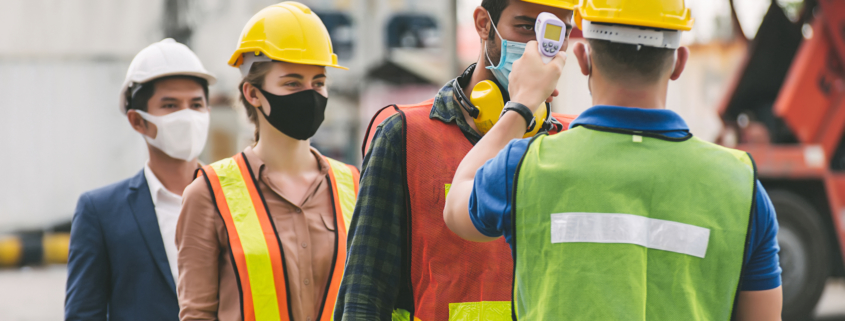In the ever-changing landscape that is the battle against the novel coronavirus, the CDC and OSHA have published workplace guidelines, and also recommend individual companies develop their own “infectious disease preparedness and response plan” to lower the risk of COVID-19 exposure and spread on construction sites.
If you haven’t yet established a safety plan for your business, here is some important information to consider, as well as valuable resources to help you through the process.
The Purpose of a COVID-19 Plan
The objective of developing a comprehensive COVID-19 policy is to ensure occupational safety on construction sites. The coronavirus pandemic has affected nearly all facets of daily life, and in order for the construction industry to maintain stability, responsible procedures are critical. Many companies within the construction industry are considered “essential business,” and thus are critical to the lives of a variety of people.
Having a written plan clearly outlines what is expected of general contractors, employees, and visitors on the jobsite, since the nature of certain construction projects may bring workers in close contact. So, it’s essential to define procedures that can help mitigate the spread of COVID-19.
The First Steps for Construction Jobsites
The first thing to consider when formulating your plan is the inherent risk level in day-to-day operations and construction activities.
Identify the areas on the jobsite (within your factory, etc.) that pose challenges regarding the potential risk of exposure to COVID-19. For example, assess situations like hallways and elevators that serve as choke points, where the physical space available doesn’t allow for social distancing.
Also take time to think about high traffic areas, in general. Assessing the unique circumstances and structure of the environment is the foundation of a good safety plan.
Components Of An Effective Coronavirus Safety Plan
Depending on where your business operates, there may be explicit mandates from the Department of Health or executive orders from the governor that are relevant to your operations and processes on the worksite. This Responsible Restart Ohio document outlines both the mandatory and recommended approaches businesses should be taking. Along with ensuring compliance with legal obligations, there are a few basic precautions every business should be observing:
Encourage Social Distancing
Although it may not be feasible in all situations, workers should attempt to maintain a physical distance of at least six feet from one another. Activities like handshaking and congregating when unnecessary should be strongly discouraged. Lunches and other breaks should be staggered as much as possible to lower the likelihood of workers coming in close contact for extended periods of time in break areas.
Stress The Importance Of Self-Monitoring
Employers should be implementing assessment practices, such as checking temperature upon arrival, to help prevent infected employees from spreading COVID-19.
Employees should also be familiar with the common symptoms of COVID-19—as well as the policy on sick leave—and encouraged to stay home if they believe they may be infected. The CDC guide for assessing symptoms and seeking medical attention can be found at cdc.gov.
Reinforce And Facilitate Proper Personal Hygiene
The core of any prevention and safety plan centers on the simple steps individuals can take to minimize the risk of exposure. Proper handwashing is essential and employees should be afforded the opportunity frequently at suitable handwashing stations.
When handwashing is not possible, the use of hand sanitizer should be encouraged.
Sneezes and coughs should be directed away from others, preferably into the arm. And, posting reminders about handwashing and refraining from touching the eyes, nose and mouth is an effective way to make sure employees keep these safeguards in mind.
Provide The Necessary Equipment And Procedures For Prevention
While it is vital to promote good individual hygiene habits among employees, it is equally important to provide sufficient means for them to consistently implement safe practices. This could include providing the proper PPE (personal protective equipment), such as N95 respirator masks, face shields or simple cloth face coverings.
In addition to PPE, employees should be equipped with appropriate disinfecting supplies and well-versed in necessary cleaning procedures. (This matter will require the most thought and planning, as it will be tailored to your operation.)
If tools and equipment must be shared, workers should be instructed on the disinfection process using alcohol-based wipes. Depending on the specific environment, it may also be necessary to regularly disinfect high-traffic, frequently-touched areas such as door knobs and handrails.
Utilize Resources To Generate An Effective Safety Plan
Many of the components of a legitimate plan are common sense. However, providing workers with clear, written guidance will help guarantee the plan is followed to the highest degree possible. Luckily, there are several places you can get assistance with creating your plan.
The Center For Construction Research And Training offers a free online template to walk you through the process.
OSHA provides extensive direction in its Guidance on Preparing Workplaces for COVID-19 document as well as a more concise reference to the most important points to consider in their COVID-19 Guidance for the Construction Workforce. All of these tools will make it much easier to ensure your business remains as safe and productive as possible.



